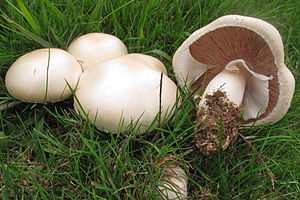White aniseed mushroom
| White aniseed mushroom | ||||||||||||
|---|---|---|---|---|---|---|---|---|---|---|---|---|

White aniseed mushroom ( Agaricus arvensis ) |
||||||||||||
| Systematics | ||||||||||||
|
||||||||||||
| Scientific name | ||||||||||||
| Agaricus arvensis | ||||||||||||
| Schaeff. |
The white anise mushroom ( Agaricus arvensis , Syn .: Psalliota arvensis ) is a type of mushroom from the family of mushroom relatives . Other names are Schaf-Egerling , Common Anise-Egerling and Schaf-Champignon . The species is popular as an edible mushroom. Its meat smells pleasantly of aniseed .
features
Macroscopic features
The stem of the fruiting body is of the same color as the hat. It is somewhat thickened towards the base, but not set off. The ring is strong, 2-scaly and often flaky. The stem becomes 5–15 cm high and 1–3 cm in diameter. The fleshy hat is initially spherical then slightly arched. The color is white to cream, dirty yellow at the top. The surface is smooth to slightly flaky and finely flaky. It measures 8–15 cm. The lamellae are whitish in the young mushroom, they then change color to whitish-gray or whitish with pink beetone, then reddish-gray to black-brown. Cheilo cystids are present.
Microscopic features
The purple-brown spores are egg-shaped and measure 6-8 × 4.5-5.5 micrometers in size.
Species delimitation
The white aniseed mushroom looks very similar to the poisonous and inedible carbolic mushroom . While the former has an aniseed smell, the doppelganger smells unpleasantly of carbolic. In addition, the stem base of the carbolic mushroom changes color to chrome yellow when cut, while the white aniseed mushroom is much less yellow. In addition, it can be confused with the deadly poisonous spring cap mushroom . In contrast to mushrooms, however, this is in a ragged sheath and its lamellas are always pure white.
The white aniseed mushroom can only be distinguished microscopically reliably from similar species such as the round-spore (Agaricus osecanus) and the large- spore aniseed mushroom ( A. urinascens ). They are also edible, but the latter in particular accumulates particularly high amounts of the heavy metal cadmium and should only be collected in very small amounts as an edible mushroom, if at all.
ecology
The white aniseed mushroom is a saprobiontic soil dweller; it grows in meadows or pastures, in parks and gardens, on sand dunes and under bushes, but is never found in forests. It grows in typical witch rings , which have an annual increase in diameter between 40 and 50 centimeters. Investigations on witch rings made from white aniseed mushrooms show that they have an influence on grass growth (investigated on red ostrich grass ( Agrostis capillaris )). There are three zones: an outer zone in which grass growth is stimulated, a middle zone in which there is hardly any grass growth and an inner zone with strongly stimulated grass growth. The species is comparatively resistant to the larvae of humpback flies of the genus Megaselia , which regularly infest other species of the genus.
distribution
The species is distributed worldwide in the temperate zones . The species is common in Europe and North America and widespread in Asia, Australia and New Zealand. In the north, the distribution area extends to Greenland.
Systematics
The species was first described in 1762 by Jacob Christian Schäffer using a Bavarian type specimen . He chose the Artepipheton arvensis ( Latin arvum = the arable land) because of the usual habitat. Within the genus of mushrooms ( Agaricus ) the white anise mushrooms on sale in the section arvensis , subsection arvensis whose type species it is.
A molecular biological study from 2004 showed as next relatives the way the Rissigschuppigen Egerling ( Agaricus fissuratus ), the Schiefknolligen anise Egerling ( Agaricus essettei ), the Rundsporigen Egerling ( Agaricus osecanus ), the Großsporigen Egerling ( Agaricus urinascens ), the Dünnfleischigen Anis -Champignon ( Agaricus silvicola ) and the Brazilian Almond Egerling ( Agaricus subrufescens ).
meaning
The white aniseed mushroom is tasty and a popular edible mushroom. It is usually collected growing wild, but it can also be cultivated on composted horse manure. However, the commercial scale of such crops is small.
Like all aniseed mushrooms, the white aniseed mushroom accumulates heavy metals such as cadmium and should only be collected in moderation for consumption.
swell
literature
- Rudolf Schubert (Ed.): Exkursionsflora von Deutschland / greeted by Werner Rothmaler. Volume 1 Lower Plants . 3. Edition. Spectrum, Heidelberg 2000, ISBN 3-8274-0655-2 , p. 454 .
Individual evidence
- ↑ a b Parra Sánchez, Luis Alberto: Agaricus L., Allopsalliota Nauta & Bas, tribu agariceae s. imai . Candusso, Alassio (Savona) 2008, ISBN 88-901057-7-1 .
- ^ PJ Edwards: The Growth of Fairy Rings of Agaricus Arvensis and Their Effect Upon Grassland Vegetation and Soil . In: Journal of Ecology . tape 72 , no. 2 , July 1984, p. 505-513 , JSTOR : 2260062 (English).
- ↑ József Geml, David M. Geiser, Daniel J. Royse: Molecular evolution of Agaricus species based on ITS and LSU rDNA sequences . In: Mycological Progress . tape 3 , no. 2 , May 2004, p. 157–176 , doi : 10.1007 / s11557-006-0086-8 (English).
Web links
- Brian Spooner: Agaricus arvensis (horse mushroom). Royal Botanic Gardens, Kew, accessed February 24, 2010 .
